An introduction to some more of our “big” grasses, now flowering beautifully after the rain. Two are climax tallgrasses, and one is (in my opinion) one of the most beautiful grasses in the country and deserves to be used more as a landscape accent.
Meet Lindheimer Muhly (Muhlenbergia Lindheimeri). All the Muhlys are pretty grasses; some are more striking than others, but Lindheimer Muhly is the queen of the lot:
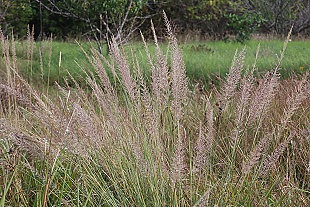
It had no supplemental water, but we did plant the root division from which this came in a lower area of the grass garden where–when it did rain–it got a little runoff. The plumes are 4-5 feet tall, and in different angles of light look pale gold or pale pinkish. Last year, with no fall rain, it put out only a few of these lovely plumes, but this year it responded to the late rain with a burst of them. The clumps spread (and it also seeded out some younger ones over the years.)
Here’s a climax tallgrass, recovering from drought and seeding abundantly, switchgrass, Panicum virgatum. In a wet year, the main mound will hit 5-6 feet in our climate, with flower stalks above that; this year the mounds were lower, but the late rain brought out the seeds:
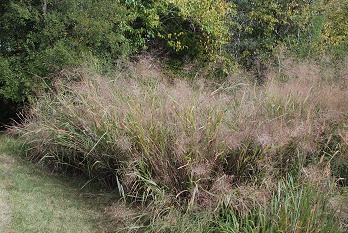
We do root transplants of switchgrass, but I will also collect and spread the seed in other low areas on the 80 acres. Some populations of switchgrass prefer to grow almost at water’s edge, and others do better on upland sites.
Though very tough, Indiangrass, Sorghastrum nutans, reacts strongly to wet and dry conditions by limiting its height. In a wet year, the grass itself will be over four feet tall; this year most of our Indiangrass stayed knee-length or below, but with the fall rains put out its striking golden spear-head flowering spikes:
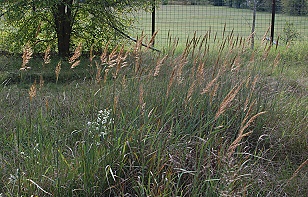
When you see it this low, it’s hard to believe it’s really a tallgrass–but it is. In a previous year, we have a picture of it towering over my head. The white flowers blooming with it are heath aster, and the few white-tipped grasses (left side) are silver bluestem, Bothriochloa saccharoides (or, newer name, Bothriochloa laguroides, Herter.)
I tried to get images of silky bluestem (non-native) seedheads, but it was breezy and they dance…to me it looks like silver bubbles tipped with copper. This is the best I could do, and it doesn’t give the full effect–but you can see the coppery “tips”:
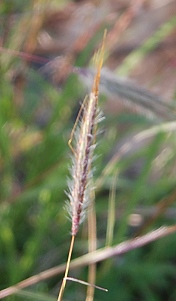
The slender stem, very flexible, dances in any breeze, and the stiff white hairs catch the light into a slender “bubble”, while the copper glows on top.
It’s not that good a grass–it’s non-native and somewhat invasive (um…quite invasive) but it’s not as tolerant of drought as the natives. When mowed to the height of native short-grasses, or in a hot dry summer, it recedes. This past six weeks of rain brought it out again, though some native grass “lawns” resisted:
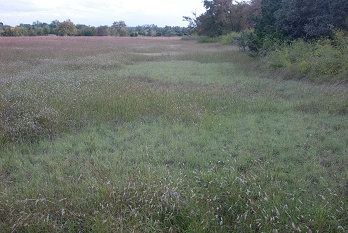
The low green patches are native short-grasses: curly mesquite, buffalograss, Texas grama. The slightly taller grass surrounding them is mostly silky bluestem; the grass with the rosy-colored flowers, a little taller than the silky bluestem, is King Ranch bluestem (another invasive, non-native, supposedly an “improved” pasture grass. ) It’s beautiful this time of year, with those purple-rose seedheads swaying in the wind, but its actual forage production isn’t that great.
What colors are out among all this green and seeding grass? That will have to be another post, but I have some pictures…including one more of Lindheimer Muhly:
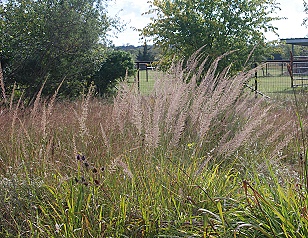
Comment by gunhilda — October 21, 2009 @ 8:28 am
Beautiful. I’ve noticed that some nurseries are carrying buffalo grass seed for lawns now as a low water/maintenance alternative to things like bermuda.
Comment by elizabeth — October 21, 2009 @ 10:11 am
A better place than nurseries to get native grass seed for lawns is Native American Seed Company, which has a large variety of seeds for grasses and forbs. I suspect the prices will be much better than a nursery.
Here’s their recommendation for a lawn mix: Native Sun Turfgrass.
I haven’t used it, because we’re trying to encourage our local populations to spread–they’ve already shown fitness in this precise location. But I would if I had a house in the city with a sunny yard.
Comment by Margaret (Merrow) — October 24, 2009 @ 6:28 pm
I love that effect of the purple haze in the distance, but will the non-native grasses cause problems?
Comment by elizabeth — October 24, 2009 @ 11:07 pm
Yes, indeed, the non-native grasses do cause problems. They’re generally less deep-rooted, and thus are less good at holding the soil and preventing erosion. They crowd out the native grasses that would otherwise grow there (and that are better food for native wildlife.) Some of them produce toxic chemicals that can harm wildlife (and livestock, for that matter…Kleingrass, which makes decent forage for cattle, can cause liver and kidney dysfunction for horses.) Johnson grass is probably the worst of the non-native invasives in our area: it’s highly toxic to livestock in some weather conditions (it produces cyanide), it’s extremely difficult to eradicate as it’s very fertile and produces abundant seed that can sprout years after it hits the ground. It’s shallow-rooted but has strong rhizomes and can sprout from any of the joints.
KRB will eventually die off on its own, but it takes years–we had thought we’d killed quite a bit of it by letting it mat down in the winter (and then the two years of drought were hard on it.) However, the rain came at the right time to make it flower and seed, so right now it’s thick.